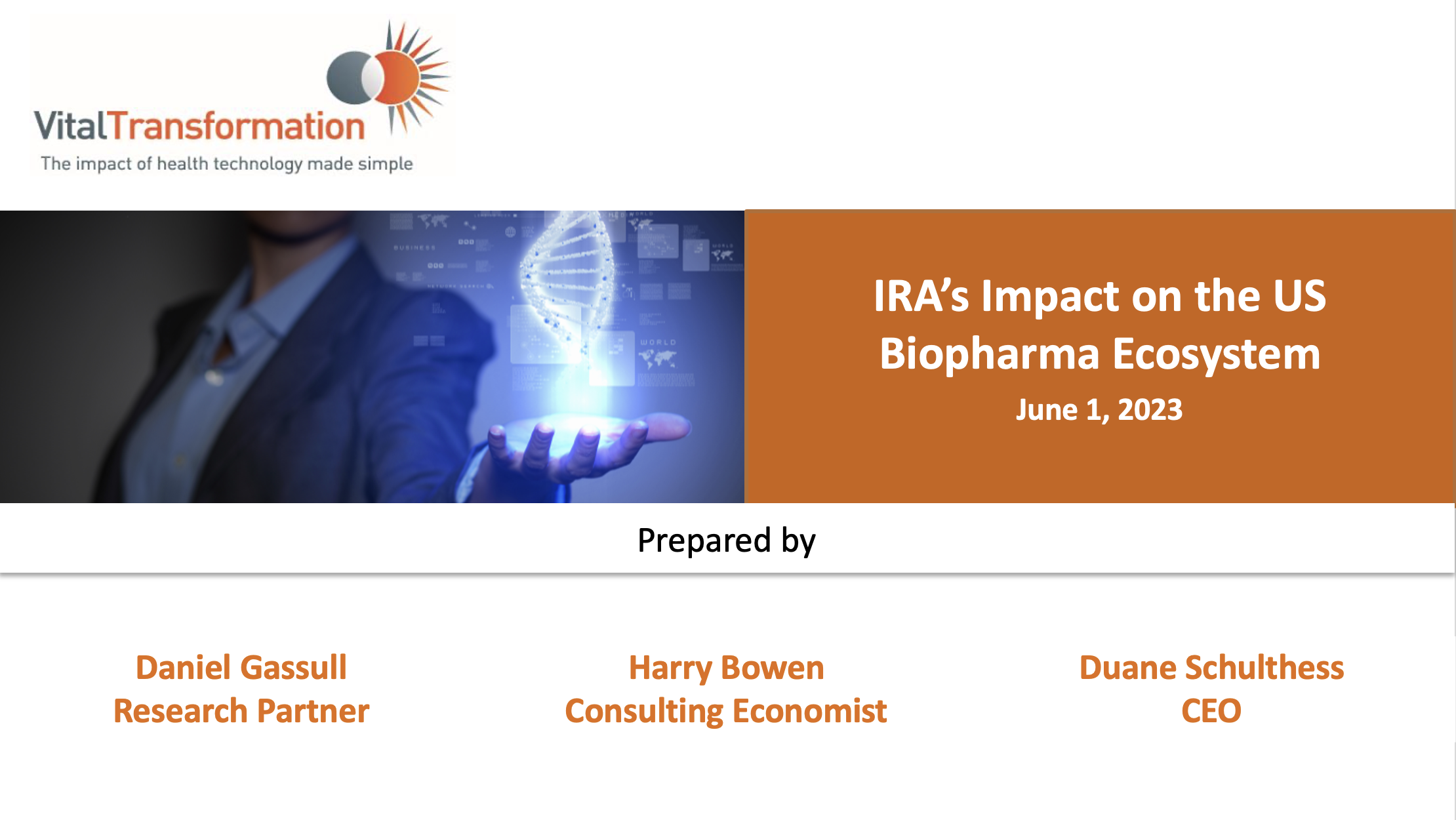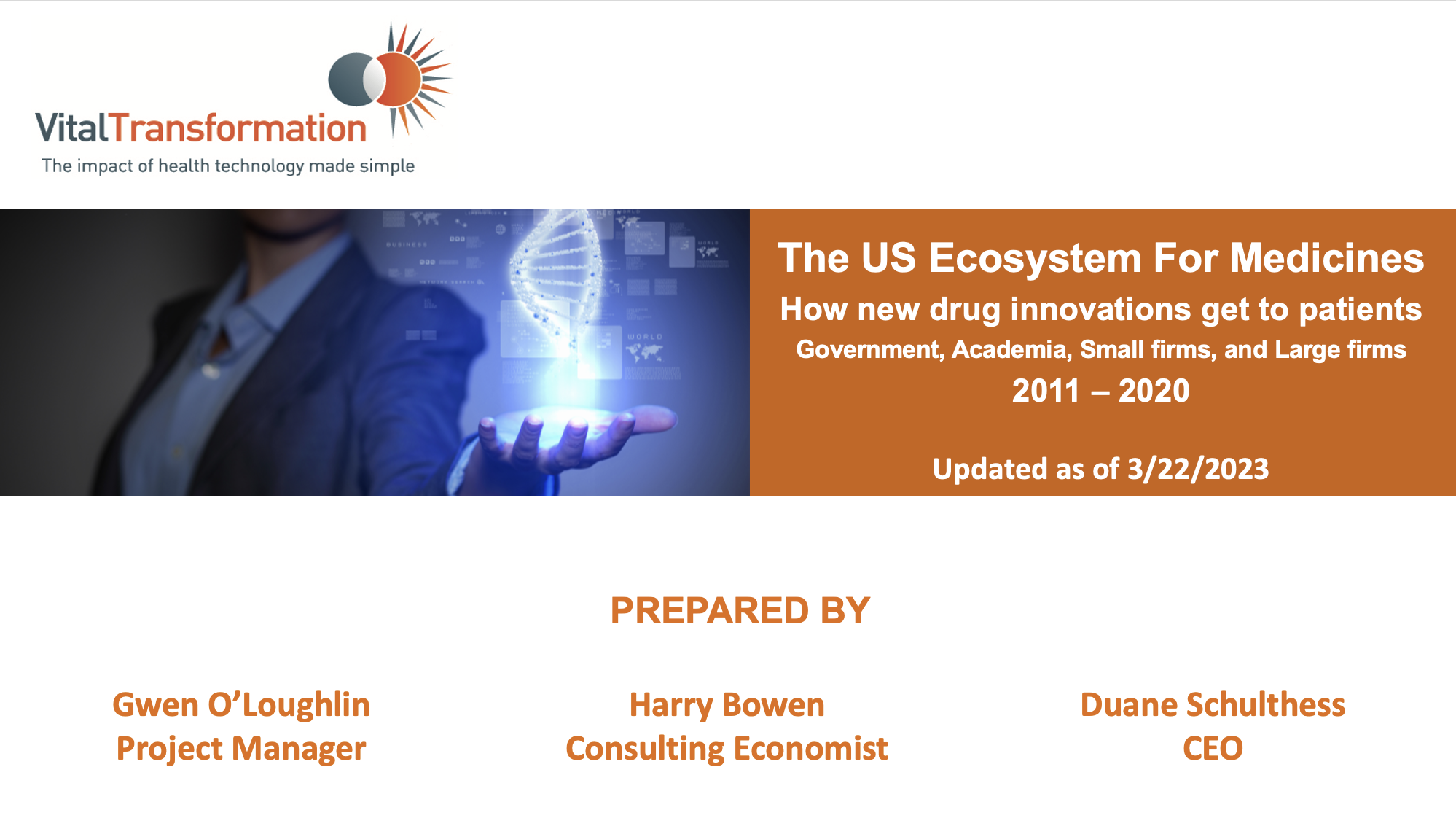LATEST RESEARCH
MORE RESEARCH
IRA’s Impact on the US Biopharma Ecosystem
Vital Transformation (VT) modeled and estimated the impacts of the Inflation Reduction Act’s (IRA) pricing provisions for a cohort of the top 200 Part B and D drugs by CMS spend, resulting in 92 drugs impacted by IRA in the next 10 years, which are produced, collectively, by 41 biopharmaceutical companies.
Had the IRA been in place beginning in 2014, we estimate the reductions in revenue on the impacted drugs to be up to 40%. Because of this, between 24 and 49 therapies currently available today would most likely not have come to market and therefore not available for patients and their providers.
Looking forward, we estimate that because of the IRA pricing provisions, the substantial reduction in revenue will significantly narrow investment opportunities. Conservatively, as many as 139 drugs over the next 10 years are at risk of not being developed at all.
Both biologics and small molecule drugs are impacted, with an average reduction in revenue per therapy of $4.9 billion and $4 billion respectively.
IRA provides a negotiation exemption for orphan drugs that treat only one rare disease. This disincentivizes investments in orphan drugs and areas of high unmet patient need as the broader indications will provide a superior return on investment, as much as $500 million over three years.
Based on two impact scenarios, we estimate a loss of between 66,800 - 135,900 direct and 342,000 - 676,000 indirect jobs in the U.S. biopharma ecosystem.
BIO 2023: A Price Control Odyssey : The Inflation Reduction Act’s Effects on the Innovation Ecosystem
The Inflation Reduction Act (IRA) contains some of the most significant changes to prescription drug pricing, reimbursement, and access since the Affordable Care Act was enacted over a decade ago. A new study by Vital Transformation, a health care economics consultancy, looks at the economic impacts on the innovation ecosystem and access to new therapies, with a particular focus on drug discovery and rare disease. As the federal government implements the price control provisions of the IRA, biotech hubs like Boston, Massachusetts- home to a significant number of established and emerging biotech companies- will bear the brunt of those impacts as they manage R&D pipelines.
Panelists, amongst whom Duane Schulthess, CEO of Vital Transformation, will discuss the studies findings, and look at the chilling effects on venture funding, orphan drug impacts, and reduced treatments reaching patients.
Wednesday, June 7, 2023, 1:45 PM - 2:45 PM (EDT) - Session Room 254B (click Read More for the session link)
And if you can't attend the session but are keen to discuss this topic, come and visit the Vital Transformation booth at the BIO Exhibition, we're in booth 1180!
The US Ecosystem for Medicines. How new drug innovations get to patients.
The dominance of American biopharma in global innovation has increased since Kneller’s publication in 2010; the USA is responsible for 95% of the increase of 111 total FDA approvals since 2010.
The diversified external R&D ecosystem, emerged since 2008, has led to an increase of more than 160% in the value of external R&D partnership in Europe and the US.
The value of Europe’s partnership deals has have remained stable since 2011, whereas the median value of partnership agreements in the US has trebled.
120 of 363 total FDA approvals between 2011 and 2020 were developed by US based small companies with less than $500 mil in revenue.
The NIH’s CRADA and Intermural grants were directly responsible for the creation of 4 of the 363 new drugs in our cohort; US academic institutions created 10% of all indigenously originated IP.
While most drugs are created by small biotech companies in the cohort, large companies step in after FDA approval with development, marketing, and scale; this appears to increase the efficiency of the Biotechnology ecosystem.
The majority of biologics undergo priority review and target orphan indications at the time of FDA approval between 2011-2020.
The NIH’s role in drug discovery, while vital, is not directly responsible for the development of new therapies.
Calculating the Value and Impact of Accelerated Approvals: Final Findings
• The Accelerated Approval (AA) pathway was implemented to help fight AIDs/HIV and has largely been considered a success in addressing areas of high unmet medical needs. However, there is growing sentiment from some payers, academics, and state and federal policymakers that the pathway needs to be significantly altered or restrictions applied to drugs approved through the accelerated approval pathway
• For most of the orphan conditions currently lacking treatment in the US, each condition impacts a maximum of 330 people – an incidence rate less than 1/1,000,000. Substantial changes to the accelerated approval pathway will likely render the potential development of these therapies to treat many rare diseases economically untenable
• The Accelerated Approval therapies’ relative impact on state Medicaid budgets is minimal with an average of one-half of one percent, 0.5%, across all 50 US states and DC
• A three-year delay in Medicaid access in 100% of states would result in roughly 19% – 43% of our therapies having a negative NPV which would therefore render development unlikely
• Revenue reductions have the consequence of increasing risks for developers/investors – even though Medicaid therapies are highly discounted, large revenue reductions do increase the likelihood of fewer therapies being introduced to the market under the Accelerated Approval pathway






